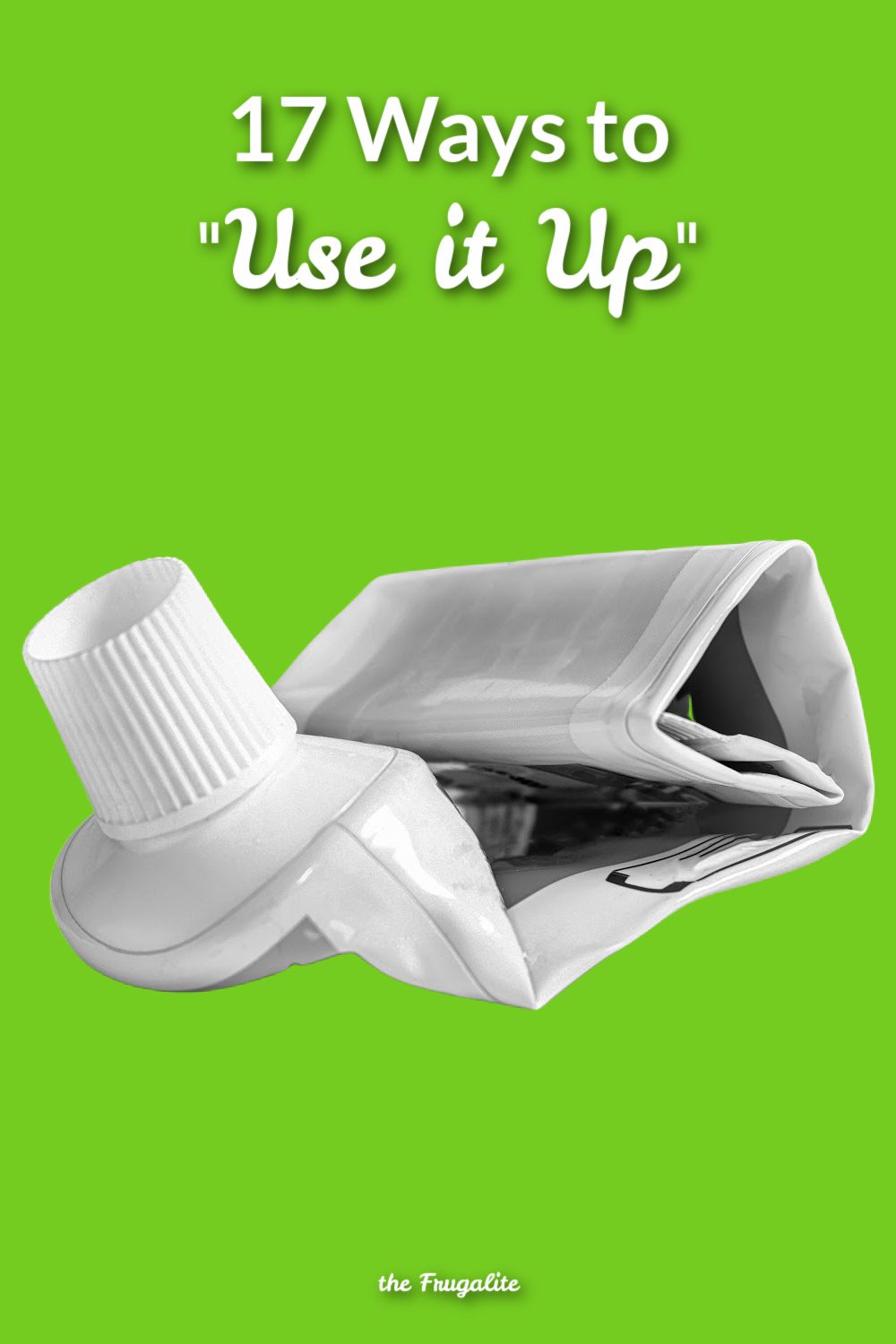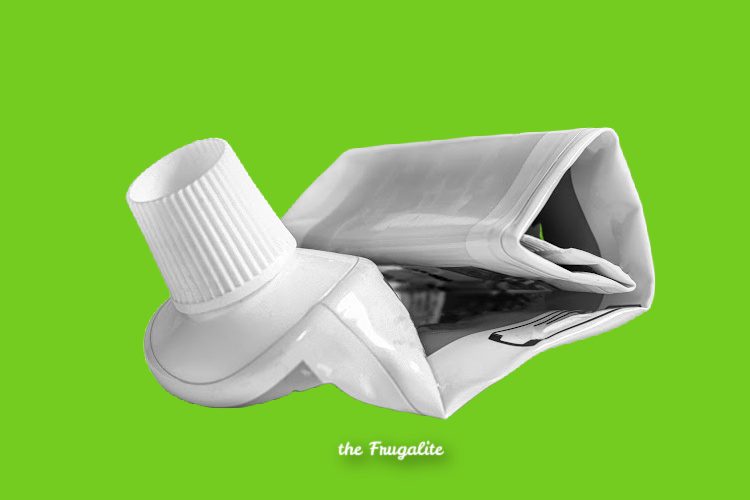(Psst: The FTC wants me to remind you that this website contains affiliate links. That means if you make a purchase from a link you click on, I might receive a small commission. This does not increase the price you’ll pay for that item nor does it decrease the awesomeness of the item. ~ Daisy)
A saying that became popular during World War II was, “Use it up, wear it out, make it do, or do without.” This could be a Frugalite battle cry to help us all get the most out of what we have without a trip to the store.
I thought this might be a great foundation for a series, so I’m starting today with “Use it up.” But I’d love for this to be collaborative so please share your best use-it-up ideas in the comments.
Ways to use it up
Frugalites know that using something right down to the very last drop is a great way to save money. The way I see it, if I’m able to get more uses out of something that others would consider empty and just throw away, it’s like getting that item for free. In fact, I always made it a game when my girls were younger to see how many more uses we could get out of something.
I’ve broken this into three categories: food, cleaning supplies, and health and beauty aids. These are things that are finite in amount – we’ll be talking about wearing things out in the next installment.
Food
The further you can stretch your food these days, the better off you are. As inflation strikes hard at the grocery store, some of these ideas may help you “use it up” when other people would just toss it out. Some of these ideas may not be for everyone, so just pick and choose the things that work for you.
Leftovers: I’ve written this article about ways to use up leftovers but there are a couple of things I want to add. When we were at our lowest point financially, I went so far as to scrape the last bites of food on everyone’s plate into my leftover soup container in the freezer. Using up your leftovers is one of the best ways to save money on your grocery bill. I couldn’t believe it when I heard that my friend’s new boyfriend “didn’t eat leftovers.” He’d grown up in a wealthy family, and leftovers were either given to the housekeeper or thrown out. She had to make them extra delicious to get him on board, but he no longer balks at the idea.
Just add water: This is a trick that applies to so many things. Did you open a can of tomato sauce and you want to get every last drop? Add some water and whisk it to get every single bit of tomato-y goodness. Has the ketchup or salad dressing bottle given its last squirt? Add some water, shake it up, and use it to season a dish that you’re cooking. For example, it could go into soup, taco meat, or mashed potatoes, depending on the flavor you’re going for in that particular dish.
Add a starch: If you have only one serving left of some meaty dish, make a sauce or dice it up and mix it with a starch to make it stretch to feed the family. Use the meat as a condiment instead of a main dish in this meal and add it to the less expensive ingredients of rice, potatoes, or pasta. Here are some more ideas for stretching food.
Cleaning Supplies
Cleaning supplies aren’t cheap, particularly if you buy brand names. This is why we recommend making your cleaning supplies and laundry soap when you can. But if you have store-bought, here are some ways to make it go further.
Use a spray bottle. People tend to overuse liquids that you just dump into your bucket or sink. I prefer to put these in a spray bottle and find that things get just as clean with far less of the product. For example, when mopping, my bucket contains only water. I put my floor cleaner in a spray bottle (make sure to get the concentration right for your surface), spritz the area, then mop it.
Change the ratio of concentrates. A lot of products are concentrates that are meant to be added to water in the first place. However, many people don’t realize this and use the product straight from the container. That is wasteful and can be damaging to your surfaces. I like to experiment with concentrates and figure out how little of the product I can use in my mixture and still get the results that I want.
Read the instructions. You know those cups doubling as lids that come with liquid laundry detergent? Most folks just fill them right up, but if you read the instructions, you generally only need a couple of tablespoons per load for a standard washer and 2 teaspoons for a high-efficiency machine. (There are other variables too – you can read about it here.) You may discover you’ve been using about 10 times the amount of laundry soap you actually need.
Just add water. This is the best tip – it applies to just about anything you want to get the most out of before throwing it out. As soon as I get dishwashing soap, I decant it into my own container and mix it half and half with water from the start. When I near the end of any cleaning product, I can always get at least one more use – and often more, by filling it halfway with water, closing the lid, and shaking it well. Then just add elbow grease.
Hygiene and Beauty Products
Getting the most out of cosmetics and personal hygiene products can be tricky. You don’t want to risk doing anything that could potentially cause illness or infection. So take care with these suggestions.
Use a pouf. You use far less body wash if you use one of those little plastic pouf body scrubbers. Now, if you’re not careful, these can be a haven for all sorts of nasty bacteria. (Here’s a really gross study from the Journal of Microbiology if you really want to know.) I haven’t had any issues. I put mine in the dishwasher each day and hang it where it can dry thoroughly.
Mix your foundation with moisturizer. If you aren’t looking for heavy coverage, you can mix your products and extend them a little further. Mix foundation and moisturizer in the palm of your hand then dot it onto your face with a makeup brush.
Reconstitute dried-out mascara or liquid eyeliner. This is a tip from my cosmetologist daughter. Add just a little bit of sterile saline solution – the kind that contact lens wearers use. It must be sterile to be safe.
Reconstitute nail polish. Is your nail polish thick, gooey, and unusable? Don’t throw it away! Add a few drops of nail polish remover and stir well to make it good as new.
Mix your favorite essential oil with unscented products. Instead of buying expensive, good-smelling products, go with plain unscented ones and add in a few drops of your favorite scent. It can be far less costly.
Use tube squeezers. There may be a better, fancier name for these little devices but whatever you call them, they’re worth their weight in gold. Tube squeezers can be used on anything that comes in a tube – toothpaste, moisturizer, balm, triple antibiotic cream, face wash…the list goes on and on.
Then cut the end off. After you have squeeeeeezzzzeedddd every drop of toothpaste et. al. out of the tube, cut the end off. Surprise – you’ll probably find at least a couple more uses in there.
Use less shampoo and conditioner. You’re probably using far more shampoo and conditioner than you actually need. Try reducing the amount of shampoo until you notice a difference in the cleanliness of your hair. Some people swear by the “no poo” method and don’t use shampoo at all. Instead, they use small amounts of other natural products. To use less conditioner, I’ve learned if I use a wide-tooth comb and comb the conditioner through my hair (and I have a LOT of wild wavy hair), I use far less.
Shower and wash your hair less often. No, I’m not suggesting you totally forego personal hygiene. But you may not need to shower and wash your hair every single day unless you are actually getting dirty and working up a sweat. If you actually skip a day here and there, your skin and hair may both thank you.
And of course…
Just add water. Are you nearing the end of the bottle of shampoo or body wash? You know the drill. Add water, shake it up, and get a few more washes out of it.
How do YOU use it up?
These are just a few ways to get the most out of products we use up and replace. Do you have some ideas to add? I know my fellow Frugalites are going to give me ideas I never even imagined. Tell me in the comments. I’m already loving this series!












8 thoughts on “17 Ways to “Use It Up””
I do many of the things listed. One thing I will be adding to my gear is the tube squeezers for a couple of my topical medications that come in tubes. I really make an effort to get everything up to the outlet when the tube is almost empty, which is fairly easy with the plastic tubes but can be difficult with the metal ones. Then I fold the rolled part up against the shoulder of the tube to get more out. Finally, I cut the tube open and get the rest. That stuff is expensive, and I have to get all of it out that I can. I am not sure I will get more out using the tube squeezer, but I am certain it will make it much easier. Thank you!
One of the things I have started doing is trying out vegetarian and vegan dishes. Now, I am a firm believer in eating meat, as it is a higher quality protein than mixing vegetable proteins to create a complete protein the way meat already is.
However, I have had to stretch meat as far as possible at times, when all my income was going to medical expenses and meat was a luxury. What I discovered was trying to stretch meat dishes was very difficult at times. Having a vegetarian friend that I was trying to find a way to make the chili normally make with ground beef that peoples seem to really like, so she could have it when we had pot lucks, I was doing quite a bit of experimenting. I did find a way to make the chili, which turned out very well, by the way. I make it for myself sometimes, just to stay in practice. It turns out that lentils cooked to a pretty soft stage, and a specific amount spooned out of the pot, letting the liquid drain back in the rest of the lentils, added to the pureed whole peeled tomatoes and pureed Ranch brand chili beans, plus the seasonings I normally use, made an excellent chili with about the same consistency and texture as the ground beef version and tasted almost exactly the same.
Well to get back to the point, in trying to get a chili recipe close to mine that she could eat I was trying vegetarian and vegan dishes, looking for one that was close. What I realized, which was a true epiphany, was that to achieve the goal of having plenty of meat protein in my diet was far easier to accomplish if I added an appropriate meat to vegetarian and vegan dishes.
They were already formulated into a good tasting dish, with ingredients that, when combined in the dish, created a complete protein. While I do not think combined vegetable protein is as good for the body as the already complete protein in meat, it was much easier to simply add the meat to those dishes than it was to try to create my own, which were initially meat dishes.
Now, I keep ingredients to make vegetarian and vegan dishes that I like fairly well, that with the addition of meat are even better. This way it is far easier to stretch the meat, while still making dishes that I like very much, that use vegetables, some of which I would have anyway, and use others that I might not normally use, but are available now, so I can practice substitutions for them, using other vegetables from storage stocks.
That got a little convoluted, but hopefully I got the idea across. Cook vegetarian dishes and add meat to them to stretch the meat, rather than trying to stretch the meat by modifying dishes that really depend on the meat to be what they are supposed to be.
Just my opinion.
I do pretty much all of these (except I don’t use makeup LOL).
Leftovers and odds and ends of different foods get cooked together in “experiments” all the time. It turns out that a lot of things go well with other things that you don’t expect. When in doubt with any kind of scraps of stew, lentils, beans, veggies, etc., almost everything is good on top of eggs (scrambled, poached, sunny-side up, etc.).
If I have to throw any food from my fridge because it’s gone bad, I consider that a failure. I usually hit at least 99% usage of all food and cleaning supplies I buy. Adding water and shaking will get at least a few more uses.
Since laundry was mentioned above, let me expand a bit on that. One of Daisy’s links above goes to an article that among other things has a link to a DIY laundry formula that works in both hot AND cold water. A non-DIY equivalent that Walmart carries is called “ALL” but you have to look at the very fine print on the back to confirm you have the right product. The significance of being able to do most of your laundry [there are a few exceptions] in cold water is multiple. Not only do your clothes last longer, you don’t have to waste the energy and money to use hot water. And if you are traveling or if your washing machine is in need of repairs, or you just want to practice for when there might be a power outage, cold water compatible laundry detergent even works well with hand/arm/muscle powered plunger style devices that you can use with a couple of 5 gallon buckets — one for the cleaning process and one for rinsing — followed by hanging on the line drying (or machine drying) if you like. The only gotcha I know of is airline travel where the TSA is paranoid about significant quantities of almost any liquid which these cold water detergents are.
Another nickel squeezer might be called the pinhole squeeze. Sometimes when you want to clean things and only need a tiny amount of water, vinegar, ammonia, etc or whatever …it’s often not easy to squeeze out, dip out, spray out, or pour out only the tiny bit you want. One solution is to use a straight pin or a sewing needle to poke a hole in the center of the plastic cap that comes with many such products, or in the plastic cap of an empty and squeezable plastic soda bottle that you can keep your solution in. Then when you need only that tiny bit, turn the upside down and squeeze away for only the tiny amount you want. That also saves you much of the cleanup mess that a larger quantity of solution might create — especially if your cleaning agent is some kind of industrial grade nasty stuff.
One trick that risks overlapping both temporary food storage and small gadgets or parts storage topics which probably says “Hello” to another part of this article series is DIY reusable tin can lids. Most traditional can openers tend to leave a nasty jagged edge on both the edge of the removed lid and on the inside edge of the can. The solution for that is to use a side-cutting can opener — often made more difficult to recognize in stores because the marketeers have relabeled them as “safe” cutting can openers, or “comfort” cutting can openers, etc. They behave differently by slicing into the outside of the metal bulge that holds the lid to the can body. That leaves a nice smooth edge on both pieces that presents no cutting threat to your fingers. The other goodie is that the lid created that way is nicely reusable whether you prefer to handle it with your fingers or with something like a refrigerator magnet. It’s a handy way to temporarily save some food that came in that can but was more than your recipe called for, eg. It also works for long term storage of all kinds of small gadgets or parts.
I have only tested three brands of such side cutters. Farberware and Good Cook side cutters are excellent and very durable. The in-house brand of Mainstay at Walmart had much of its quality “Walmarted” out of it, and the molded plastic cranking handle disintegrated in only a couple of months of use. FYI.
–Lewis
When buying a new product I’ve learned the hard way to check the container. Recently bought a face moisturizer in a pump dispenser. Wrongly assumed I could open it when at the end – have found no way other than sawing it open. Will go back to my little tub where I can get every last drop.
For the past 40+ years I’ve used cold water in the washing machine and never had a problem. Before switching to liquid detergent I would dissolve the powdered in cold water and then add to the washer so didn’t have clumps of undissolved detergent. This started as a necessity when hubby stationed in Sicily and there wasn’t a hot water hookup for the washer.
Food – yes a little water goes a long way in getting out all the food from a jar or can. I save the liquid from canned vegetables to use in place of water – I do try to always buy no salt added products. I add a little vinegar with a little water to clean out salad dressing bottles. You’ll often find narrow necked bottles upside down in my refrigerator getting those last drops easy to access. I also watch the shape of jars – my favorite salsa comes in an easy to hold, but hard to clean out jar.
Forgot one. Though I have not proved it out yet. I purchased wool balls to use in the dryer (I cannot hang clothes outside at the apartment building) instead of dryer sheets. If they work, that will be one long(er) term saving.
Another that I just remembered, and again have not proved out, is the use of magnets (specially coated for safety and noise reduction) in the washer rather than detergent. When I get a chance and can acquire some, I will test them and see if it is hype, if it works, or if it helps and reduces detergent use.
If anyone else has tried either of these I would be interested in hearing their opinions.
Just my opinion.
I have been using both the washing machine balls & wool dryer balls about 5 years now. Have to say I love both!
The washing machine balls I have work very well on most of our laundry without any detergents. I let them air dry after use & instructions for mine suggested placing in direct sunlight once a month to recharge.
If I use detergent on a particularly nasty batch of cleaning towels or other laundry, the amount of detergent and sanitizer needed is greatly reduced. I do still have to use a stain remover on my husband’s dress shirt collars once in awhile. Overall, these washing machine balls are well worth their cost, in my opinion.
I love the wool dryer balls! They soften even the stiffest blue jeans & work pants or the heaviest bath towels. When our weather permits, I hang many things outside on the clothesline & then just tumble dry those items for 15 minutes to soften & fluff.
I have never used Tube savers I cut the bottom of the tube after the tube is flat and get the remaining toothpaste out, this saves money on buying Tube Savers.
Sorry I called them tube savers instead of tube squeezers also a scissor works best for cutting the tube